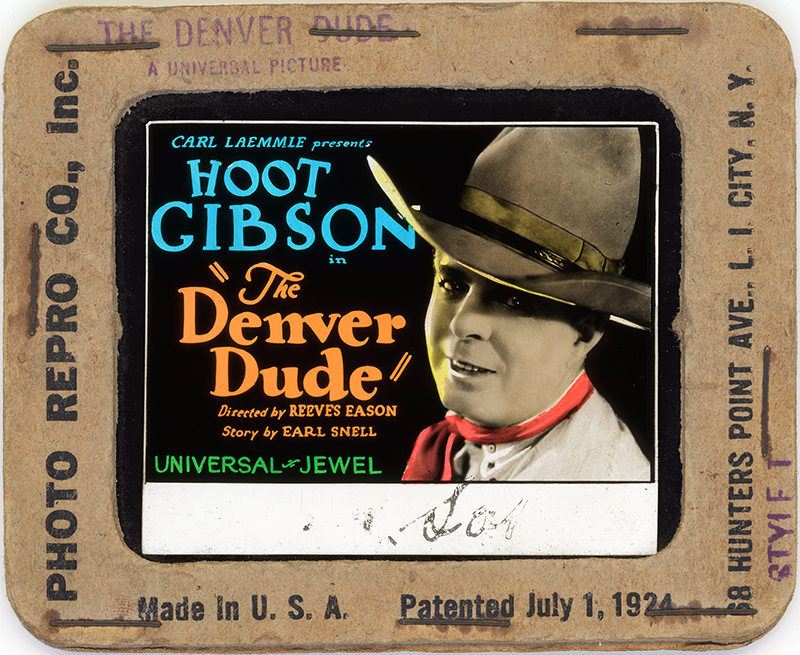|
|


Click image to enlarge
Directly on the heels of 1927's "The Silent Rider" (January 2) came the second of two back-to-back pairings of Hoot Gibson and Blanche Mehaffey in Universal Pictures' "The Denver Dude," released February 13, 1927. A popular rodeo star throughout his film career, Gibson was already making appearances at the annual Saugus rodeo and would purchase the local rodeo arena in 1930. On June 28 of that year he married actress Sally Eilers at his ranch home on the property. It later became the Saugus Speedway. Presented (produced) by Carl Laemmle and directed by B. Reeves Eason with cinematography by Harry Neumann, "The Denver Dude" also features Robert McKim, Slim Summerville, Glenn Tryon, Howard Truesdale, Mathilde Brundage, Rolfe Sedan, Grace Cunard, Buck Carey and Gilbert Holmes. We don't know where it was shot — and we may never know, because we can't see it. "The Denver Dude" is a lost film. Like more than half of the silent movies ever made, it no longer exists. All we have are some of the advertising materials for it such as this magic lantern slide. (Today we have movie trailers to promote coming attractions; back then they had magic lantern slides.)
About Hoot Gibson: Edmund Richard Gibson earned the nickname "Hoot" when he worked as a messenger for the Owl Drug Co. He was born August 6, 1892, in Tekamah, Nebraska and appeared in more than 200 films (including short features) between 1910, when he earned $50 for his role in "The Two Brothers," and 1960, when he made an uncredited appearance in "Ocean's Eleven." Gibson did most of his work as a silent cowboy actor between World War I and the early 1930s. He directed a bit in 1920-21 and produced some of his own films from 1923-30. The 5'9" Hollywood giant died of cancer on August 23, 1962, in Woodland Hills — five days before a wildfire burned down Gene Autry's Melody Ranch in Placerita Canyon, where Gibson made some of his movies. In addition to using the Santa Clarita Valley as a backdrop for filming, during the time he was married to Dorothea Sally Eilers (a popular leading lady in late silents and early talkies), he owned a ranch in Saugus now known as the Saugus Speedway. SCV historian Jerry Reynolds writes: "Roy Baker purchased a 40-acre tract east of Bouquet Junction during 1923, starting construction on a rodeo arena a year later. Hoot Gibson bought the ranch and stadium in 1930, putting on shows that attracted such stars as Tom Mix, John Wayne and Clark Gable. In 1934 Gibson sold out to Paul Hill, who ran the Western Livestock yards and leased it to film companies for three years until a huge flood filled the home and arena with mud and debris. (Hill) was unable to make payments, and the bank repossessed the property, which was eventually taken over by a professor of economics at Occidental College, William Bonelli (who started the Santa Clarita Water Co. and built one of the first local housing tracts in the late 1940s). Today (the rodeo arena) is known as the Saugus Speedway." About Blanche Mehaffey: Blanche Mehaffey was born in Cincinnati on July 28 in either 1907 or more likely 1908. Her mother, Blanche Berndt, was a soprano singer, and Blanche was a very young Ziegfeld Follies dancer before coming to Hollywood and landing her first film role in the 1923 Hal Roach picture, "Fully Insured." Mehaffey appeared in several Hal Roach silent comedies during the 1920s. Hollywood had fully embraced sound by 1929, so she went to New York and studied voice for more than a year. She returned in 1931 to appear opposite Bob Steele in her first talking picture, "Sunrise Trail," a Trem Carr Western shot in Placerita Canyon. Mehaffey was briefly married to oilman George Joseph Hausen and to film producer Ralph M. Like. She retired from the screen in 1938 and died in Los Angeles 30 years later, on March 31, 1968. Her grave marker at Forest Lawn-Glendale reads "Blanche M. Collins."
LW3297: 9600 dpi jpeg from original lantern slide purchased 2018 by Leon Worden.
|
The site owner makes no assertions as to ownership of any original copyrights to digitized images. However, these images are intended for Personal or Research use only. Any other kind of use, including but not limited to commercial or scholarly publication in any medium or format, public exhibition, or use online or in a web site, may be subject to additional restrictions including but not limited to the copyrights held by parties other than the site owner. USERS ARE SOLELY RESPONSIBLE for determining the existence of such rights and for obtaining any permissions and/or paying associated fees necessary for the proposed use.








